Performance Max revolutionized the way marketers advertise on Google, allowing them to advertise across Search, Youtube, display, Discover, Gmail, and local with a single budget and different creatives. Some have fallen in love with the ad type because it removes the bias from budget allocation, while others distrust it because PMax doesn’t allow for as much control and reporting as conventional Google campaigns.
However, the biggest reason PMax is such a polarizing campaign type is because there are no concrete best practices on what makes a successful PMax structure. So, we decided to investigate the most common PMax trends and shine a light on the ones that perform best as well as the tactics that underperform.
In this study, we’ll assess:
- Whether what the majority of advertisers are doing is profitable
- The impact of other campaigns on PMax
- Whether human bias affects performance
- How creative and targeting choices impact PMax
- What a ‘healthy’ PMax campaign looks like
Methodology
Before we dive into the data, it is worth noting that there is a mix of ecommerce and lead gen campaigns in the cohort.
- A total of 9,199 accounts and 24,702 campaigns are included in the data.
- Accounts had to be at least 90 days old and have conversions.
- Accounts had to have at least $1,000 monthly budget and could not exceed a $5 million monthly budget
We did our best to account for different structure and creative choices, however data at this scope cannot perfectly segment out each use case. We dug into a random assortment of accounts in each question (below) to confirm trends we’re seeing.
Data Questions & Observations
Below, you’ll find the raw data from the study. We’ve also organized the findings in the sections that follow.
Raw Data
Typical structure:

Impact on performance when an account was below or above the average for typical structure:

Only PMax or Media Mix:

Other Campaign Types Present:
This table shows the performance of the PMax campaigns when an account did or did not have the specified campaign type.
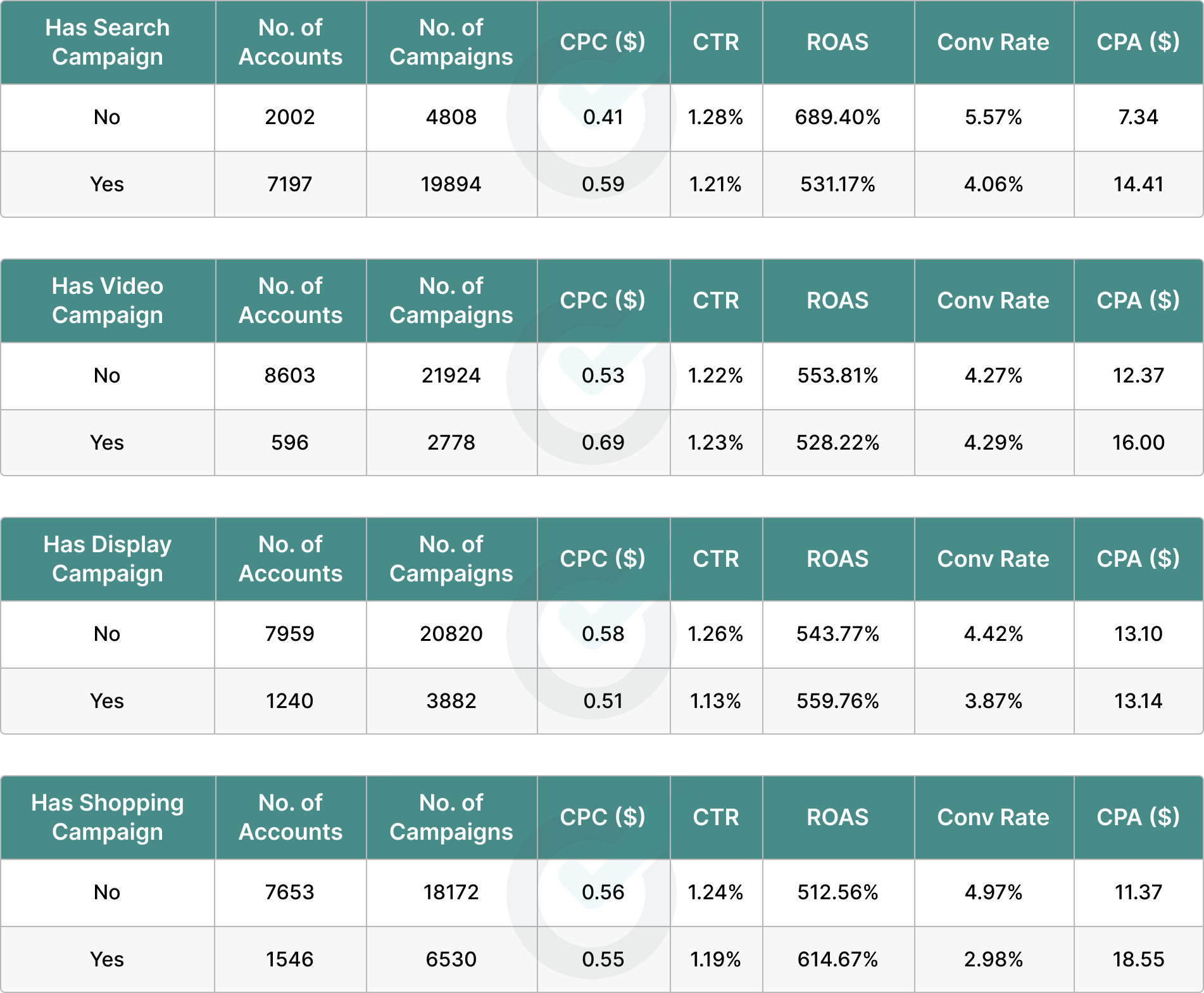
Bidding Strategies Used:
This is the breakdown of how each bidding strategy in PMax performs.

Impact of Using Exclusions:
This data shows the impact of using brand exclusion lists and other types of exclusions (negative keywords, placements, and topics).
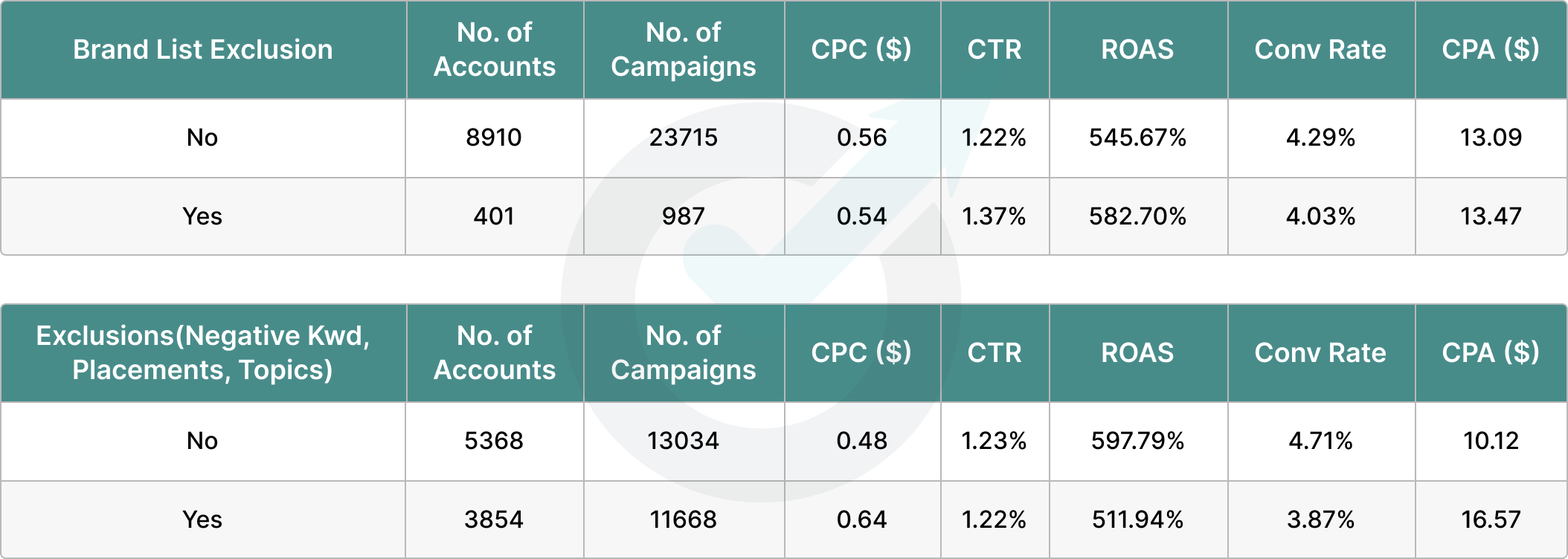
Is Feed Present:
This data highlights whether there’s a feed in the PMax campaign.

Impact of Audience Signals:

Impact of Search Themes:

PMax Structure:
In the interest of making it easier to understand each Pmax campaign type, we’re applying labels to them:
- Starter Campaigns: one campaign/one asset group
- Focused Campaigns: multiple campaigns/one asset group
- Conversion Hungry Campaigns: one campaign/multiple asset groups
- Mixed Campaigns: multiple campaigns/multiple asset groups
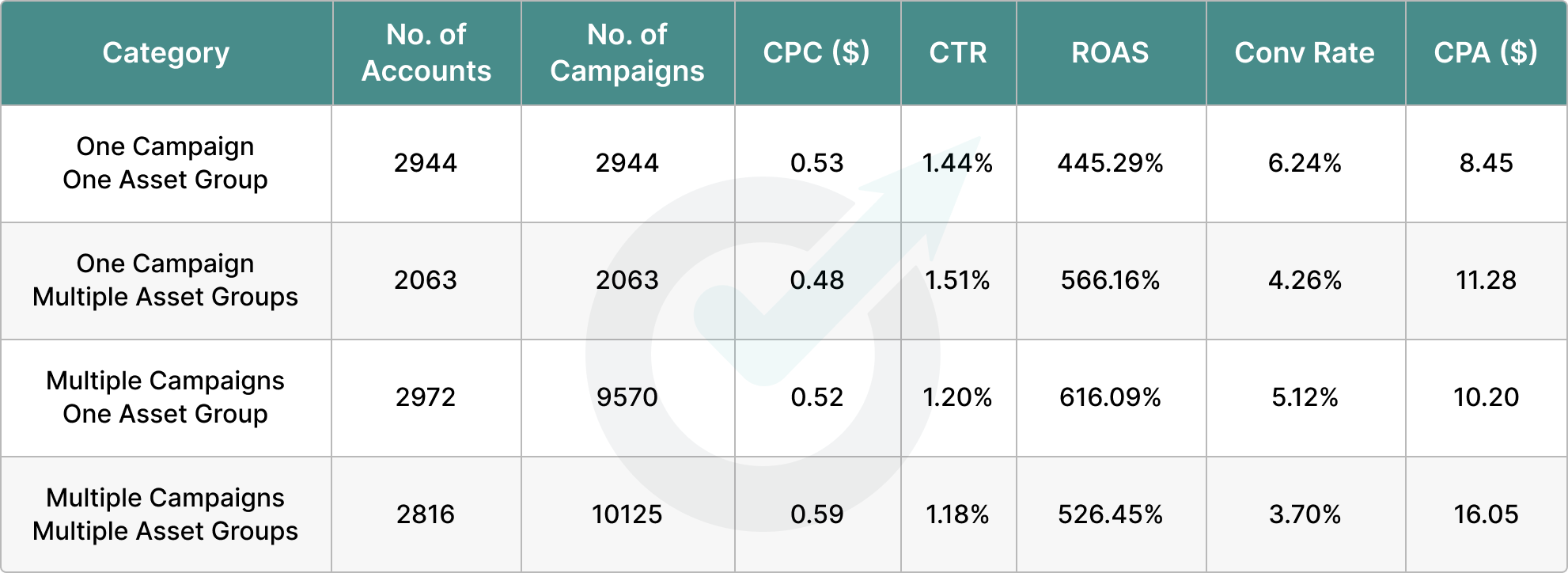

How Many Conversions Does PMax Need?

Number of Assets and Types of Assets:

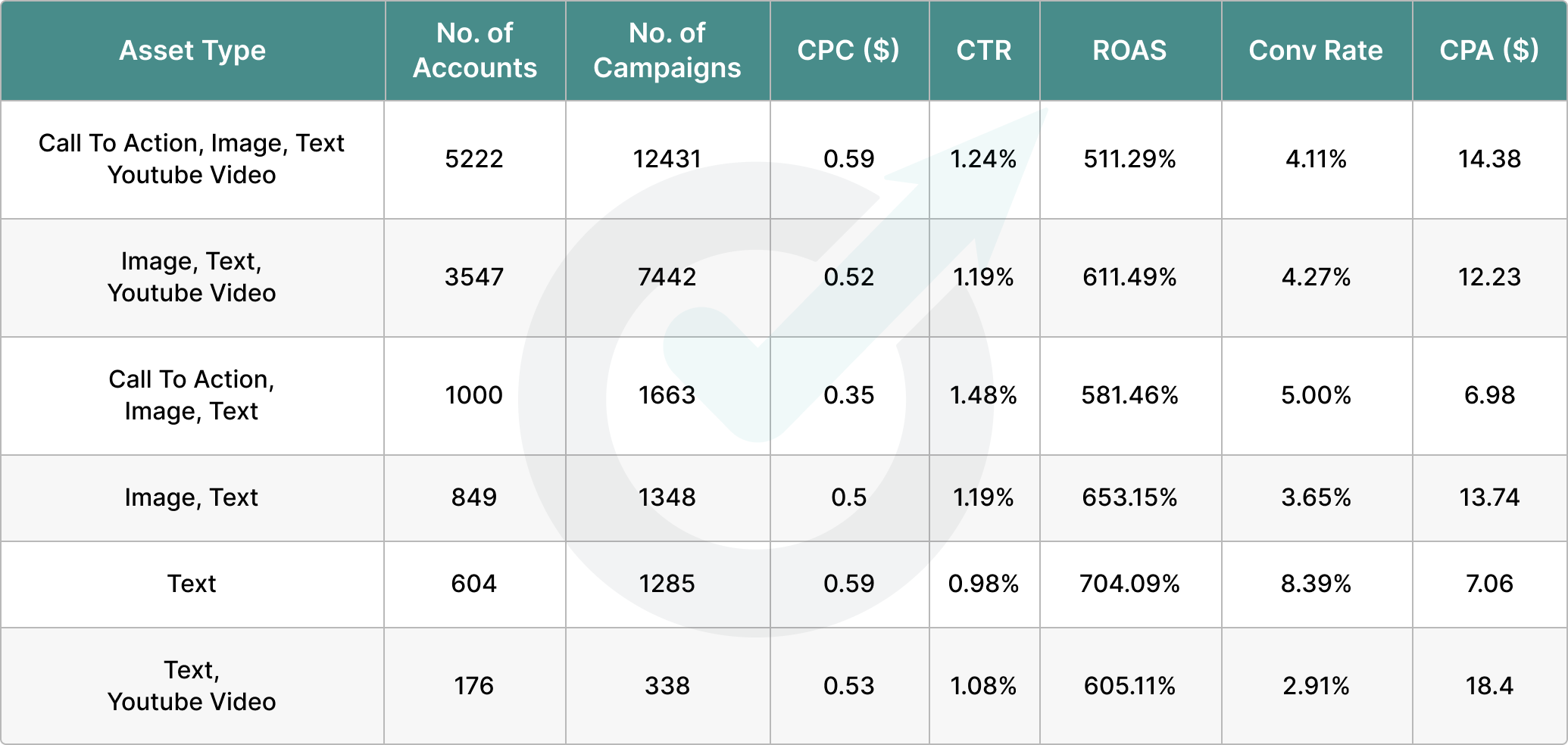
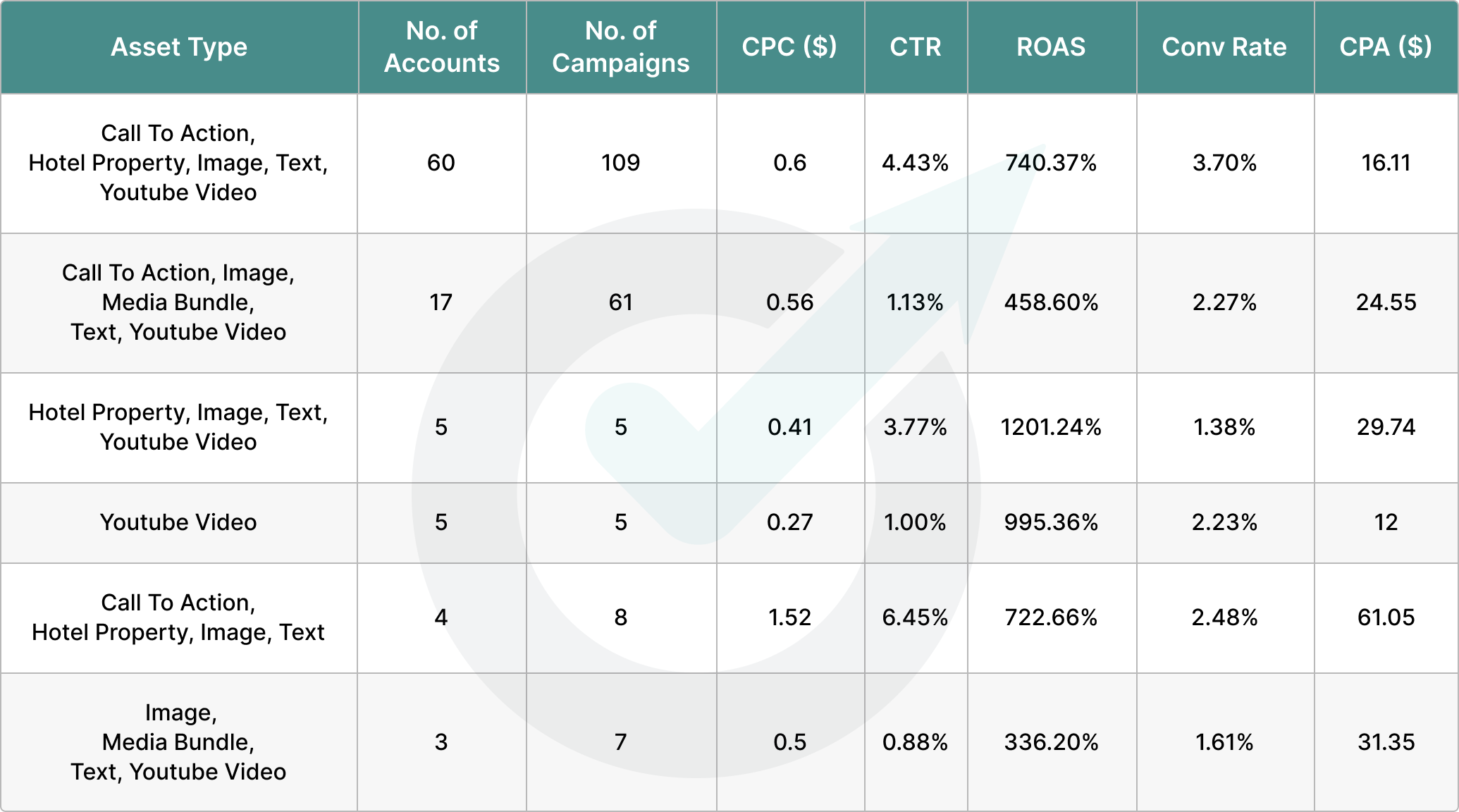
*note there aren’t enough statistically significant amount of advertisers using hotel ads, but we wanted to share the data for those who do use that format.
Percentage of Spend Going To PMax:

What Are Most Advertisers Doing & Is It Profitable?
We organized the findings by major category.
PMax Structural Choices
- Most advertisers (82%) in the study run Performance Max alongside other campaign types. The data shows PMax campaigns struggle when paired with other campaign types, which lends credibility to Google’s claims that other campaigns will take priority over PMax.
- In addition, there is no clear majority on PMax structure. With that in mind, multiple campaigns with a single asset groups have the best ROAS, second highest conversion rate, and CPA. A single campaign with one asset group might win on CPA and conversion rate, but has the weakest ROAS.
- A slight majority of advertisers (55%) don’t use feeds in their PMax campaigns, and see better conversion rates and CPAs, with weaker ROAS. One can infer accounts with feeds are ecommerce and using Max Conversion Value.
- Most accounts meet the 60+ conversion threshold needed for success with PMax. Those who didn’t saw worse performance across the board (save CTR).
Pmax Strategy Choices
- A slight majority (55%) use the Max Conversion Value bid strategy. 45% use thes Max Conversions bid strategy. Predictably, Max Conversion Value does better with ROAS, while Max Conversions does better with CPA and conversion rate. CPCs and CTR are slightly better for Max Conversion Value.
- Surprisingly, the majority of advertisers don’t use exclusions (brand lists, negatives, topics, and placements). Most advertisers (58%) saw a slight improvement in performance when they had no exclusions, but it was ultimately flat. It’s worth noting almost no advertisers use the brand list exclusions (97%) and it was even flatter.
- Ninety-two percent of advertisers use audience signals and their accounts struggled on all metrics, save for CTR and ROAS (which were essentially flat). This puts in question whether it’s worth the effort to add in audience signals and if the data seeding the signals can be trusted.
- Seventy-one percent of advertisers use search themes and results are mixed, but mostly favor NOT using them.
- Most marketers (57%) use all assets available (call to action, text, video, and image). They achieved ‘average’ performance across the board. Interestingly, the ‘best’ performance belonged to PMax campaigns using only text assets. However, this defeats the purpose of PMax, which is designed to help budget go where it can do the most good (visual content and text content). It also illustrates that our perception of ‘best’ is skewed by a search bias.
Perhaps the most surprising insight is how much budget advertisers allocate to PMax—51% of advertisers allocate more than 50% of their budget to this campaign type. Campaigns in these accounts have the strongest ROAS, however every other metric is mixed.
What Impact Do Other Campaigns Have on PMax?
I was not expecting other types of campaigns to ‘triumph’ over PMax campaigns in the same account: Many advertisers assume that PMax will cannibalize branded search and will get preferential treatment in the auction. However, the data seems to suggest that PMax almost always takes a backseat to siloed campaigns.

While the most common other campaign type (Search) had the most obvious wins over Pmax, Shopping had fairly impressive wins as well.
It’s worth noting that visual content (Video and Display) is fairly flat on ROAS, and Display is flat on CPA. This suggests that these campaigns are not as focused on conversion.
Percentage of Spend Going to PMax:

As I mentioned above, there are a surprising number of marketers putting more than 50% of their budgets towards PMax. While these marketers saw the strongest ROAS in their PMax campaigns (625.03%), there are also potential conversion rate and CPA advantages when keeping PMax limited to 10%–25% of the budget.
Does Human Bias Help or Hurt PMax Performance?
PMax’s core guiding logic is ‘profit without bias.’ However, this is also a source of friction for advertisers who are used to having near-complete control. Based on the data, it seems like adding exclusions hurts performance.
This could be for a few reasons:
- Branded traffic is cheaper and has better conversion rates. That said, performance was fairly flat between brands that excluded branded terms and those that left them in.
- The exclusions were too strict and caused performance issues due to missed placements.
While we can’t say that the exclusions were inherently a bad idea, they represent clear bias around what we think has value. Based on the data, there may be value in loosening exclusions, leaning into content safety settings instead.
The relatively flat performance between these differing tactics is interesting, but not conclusive.
How Do Creative & Targeting Choices Impact PMax?
There’s a common assumption that doing more work on a campaign should lead to better results. Taking the time to teach the algorithm what you value should lead to better results.
However, the data seems to contradict this assumption.
Impact of Audience Signals:

Impact of Search Themes:

As we can see, performance is flat (or worse) when Audience Signals and Search Themes are included. This seems to indicate that investing the effort on these tasks isn’t worth the ROI.
However, it’s also worth remembering PMax will take a back seat to siloed campaigns. Search Themes remain one of the most powerful ways to ‘mark’ traffic for PMax (over siloed campaigns). This is because Google prioritizes exact search terms going to exact match.
Brands should be intentional with audience signals and search themes, treating them as guidelines instead of hard targets.
With regard to creative, while the majority of advertisers lean into all assets, there seems to be a decided benefit to just including the assets you can reasonably support. There is no denying the text-only asset cohort skews the numbers for including one asset, however the correlation on ROAS supports not including creative just for the sake of it.
It’s also important to remember the wide ranges of CPAs reflect a wide range of industries, and there are some categories with statistically insignificant data.
Number of Assets and Types of Assets:



If there’s one ‘magic’ creative button for PMax, it’s video. While text-only had the best overall metrics, those are limited exclusively to Google Search. Video’s strength is that it keeps up with text while accounting for lack of focused transactional intent.
From these two datasets, you can see that it’s best not to mindlessly fill out all the fields. Be intentional about your targeting and creative choices, honoring the point of the ad channel you’re using to reach customers.
What Does a Healthy PMax Campaign Look Like?
Now that we’ve investigated what the majority of advertisers are doing, let’s look at some directional queues we can take from the data.
PMax Structure:


The metrics seem to favor running multiple campaigns with one asset group per campaign, allowing brands to utilize unique budgets and negatives. However, there are also CPA and conversion rate gains associated with one campaign-one asset group.
This inspired us to investigate whether the latter group were ecommerce advertisers building on the habit of Smart Shopping (which didn’t require as much segmentation). However, most marketers in this category didn’t attach a feed and had better results. So, there is something to the single campaign and asset group strategy.
These findings run counter to the data that we pulled last time and shows Google has significantly improved how it understands user queries. That said, if you can find the conversions, multiple campaigns with a single asset group are the way to go because they guarantee budget access for the parts of your business you care about.
We took some benchmarks on how most of the 9,199 accounts are structured and found the following averages:
- 3 PMax campaigns per account
- 4 asset groups per campaign
- 34 assets per asset group
We explored accounts that fell below and exceeded these numbers:

These figures are mostly impacted by the number of asset groups and assets. The data seems to indicate fewer and more thoughtful entities have a higher chance of success than loading up on all the assets and asset groups.
Finally, we couldn’t have a complete conversation about healthy campaigns without diving into conversion thresholds.
How Many Conversions Does PMax Need?

It shouldn’t surprise anyone that PMax needs more conversions to be useful, but what is surprising is how flat CTR is compared to conversion rate. I would have expected CTR to have more volatility at lower conversion rates, (due to Google trying to figure out which traffic is valuable).
This data supports the idea of limiting campaigns if you won’t be able to hit 60+ conversions in a 30-day period.
Tactics from the Data
As we stated previously, we’re not going to declare one path as correct or incorrect. However, based on the data, we feel confident sharing the tactics below:
- Multiple asset groups in the same campaign don’t work as well as ad groups in a campaign because there aren’t asset group-level negatives. Depending on your budget and ability to meet conversion thresholds, you can decide to run a single PMax campaign with a single asset group or multiple campaigns with a single asset group.
- Be careful about biases on where ads should serve and how many negatives to include. While some exclusions are necessary for brand safety, the data is clear that PMax needs fewer limitations on its learning. Consider using account-wide exclusions over campaign-level ones.
- PMax is designed to work in concert with your other campaigns, and brands that rely solely on PMax (as well as brands that run Pmax on auto-pilot) will struggle to achieve sustainable results. Brands that use PMax as a testing ground for keyword concepts, placements, and other insights will get more out of this campaign type because they are allowing the bias-free traffic to add incremental gains.
Experts React
“It was super exciting to dive into research that explores such a dynamic and evolving campaign type as Performance Max (PMax). This study offers valuable insights that both confirm and challenge established PPC strategies.
One of the standout findings is the critical importance of conversion volume. The data reinforces the idea that achieving an optimal level of conversions is essential for campaign performance. This makes it a key consideration when planning or restructuring campaigns - ensuring enough conversion data is present to enable effective machine learning and optimization.
I also found the analysis of campaign and asset group configurations intriguing. While it would be useful to further explore how these configurations differ across ecommerce and lead generation accounts, the findings can serve as a solid foundation for further experimentation and optimization.
Moreover, the study challenges some widely accepted beliefs about audience signals and search themes. The findings suggest that adding more signals doesn’t always result in significant performance gains, which prompts a re-evaluation of the resources invested in these areas. This invites a fresh perspective on how we approach campaign management - focusing less on volume of inputs and more on the quality of core components like conversion data and asset structure.”
Julia Riml, Director of New Business, Peak Ace
“The most important finding to me (and further confirming what we already knew) is the importance of sufficient conversion volume which is important for machine learning to work to it’s full potential and which also guides our optimization steps.
The aspects I found most surprising were how many advertisers seem to be running PMAX as a standalone campaign (without search, video and display campaigns accompanying it) and that PMAX campaigns that didn’t utilize a feed (lead generation?) on average tend to perform better with regards to CVR and CPA.
Lastly, it shows the importance of diversifying your spend - the more you spend on PMAX in relation to other campaign types, the worse your CVR and CPA tend to be.
Super intriguing stuff and a must read for everyone working with Google Ads."
Boris Becceric, Google Ads Consultant, BorisBecceric.com
“I am a PMax skeptic, however this analysis presented me with a few surprises, in among what we already know to be true. It is not a surprise that PMax performs better with max conversion value and with more conversion data. However, I am surprised at the amount of advertisers spending the bulk of their budget on PMax, and at the impact (or lack thereof) of exclusions.
As with anything in the PPC world, it remains important to assess your individual business context. What metrics are most important to you? At the very least, I’d argue PMax now deserves to be tested by everyone who can accurately assess/import conversion value.”
Amalia Fowler, Owner, Good AF Consulting
“This Performance Max study provides valuable insights into the strengths and weaknesses of this Google campaign type. The most striking finding I noticed is that PMax often plays a secondary role compared to other campaign types like Search and Shopping, indicating that PMax does not always receive preferential treatment in the auction process.
The data suggests that multiple campaigns with a single asset group yield the best ROAS, and that limiting exclusions and avoiding the indiscriminate addition of assets are key to success. Despite the growing adoption of PMax, human bias can sometimes hinder performance by imposing too many restrictions. From my experience and knowledge I would highly recommend to make sure to test best practices and always be aware that it’s not a one-size fits all campaign type.”
Lars Maat, Owner, Maatwek Online
“One of my biggest takeaways from this study is that PMax seems to perform better when it’s targeted well and not used more broadly. For example, multiple campaigns with one asset group being one of the highest performers stood out to me. PMax learns at the campaign level so, perhaps these campaigns are more highly targeted allowing the campaign to learn exactly who to target. While the one PMax with multiple asset group set up more than likely has variation by product or service type meaning multiple types of customers need to be targeted. As mentioned, PMax lacks the ability to have asset group level exclusions or asset group level ROAS/CPA targets to help control for variations in users or goals. Additionally, that campaigns with fewer assets seemed to perform better suggests that more targeted creative is a better option than generic or broad assets.
Based on this study, with the data and signals that PMax has access to, it seems that focusing it on targeting one customer type with plenty of data can be a successful strategy. This would allow you to keep your creative narrow and use only very specific signals.
As always, this is another excellent thought provoking study into Google Ads from Optmyzr!”
Harrison Jack Hepp, Owner, Industrious Marketing LLC
“Another insightful case study by Optmyzr. Some of the results are consistent with the finding of the previous one on bid strategies - Max. Conv. and Max. Conv. value again deliver what is expected from them.
An important finding for me is the benchmark of 61 conversions, which can explain why sometimes single PMax campaigns can be the better option. Still, some of the results suggest that multiple campaigns with a single asset group are a great option too. For E-Commerce, I have a clear preference for Performance-Based-Bucketing and in my experience multiple campaigns deliver better performance than a single consolidated campaign.
The case study undoubtedly demonstrates that human bias can hurt performance. I was aware that Search themes have negative effects on other campaigns, but now I am surprised that they might be having them on PMax too. The most surprising results regard the use of Audience signals (associated with negative performance effects) and the efficiency of PMax for Lead Gen accounts. I am ready to adjust my strategy and leave out Search themes and Audience signals behind (probably except for Customer match and Remarketing lists) and give more chances to PMax for LeadGen.”
Georgi Zayakov, Senior Consultant Digital Advertising, Huttler Consult
“The fact that Performance Max (PMax)-only campaigns show higher ROAS doesn’t surprise me, as PMax often behaves like a bottom-of-funnel conversion campaign. When other campaigns, such as non-brand search, are run alongside PMax, I expect metrics like ROAS and CPA to be worse, since these campaigns target different stages of the funnel and often require more consideration from consumers.
One particularly interesting finding is the limited use of PMax alongside YouTube video campaigns. Despite the control YouTube offers, PMax seems to underutilize video, reinforcing its role as a bottom-of-funnel tool, however I would have expected the ROAS difference to be higher.
I’ve also found that standard shopping campaigns often conflict with PMax, so seeing higher ROAS in these cases is surprising—though I’d handle this on a case-by-case basis.
The study’s insight into a single asset group driving higher ROAS is fascinating. I typically run different creatives for seasonal campaigns or separate product lines with similar margins in their own asset groups under one Pmax campaign. However, this data suggests that brands can simplify their approach, running a multi-product photoshoot with a branded YouTube video and still see success. This significantly lowers the creative burden for advertisers.”
Sarah Stemen, Owner, Sarah Stemen LLC
“My team found this report immensely helpful and illuminating. We have heard conflicting things from Google on Search themes, for instance. It was helpful to confirm our suspicions that they don’t have much impact on PMax performance so we can invest our energy elsewhere. We are still pondering the study in general as to how it will practically impact the way we segment campaigns, but there are certain things we gained immediately from it. We always create Standard Shopping campaigns in accounts, even if they are PMax heavy, so it was encouraging to see this supported in the study and we have more confidence in the energy we invest in that effort now that we have read the study. I also was particularly intrigued by another study (similar to the one Mike Ryan and SMEC did awhile back) looking at conversion volume. Without a doubt now after these two studies, a significant amount of conversions are needed to increase confidence levels in PMax success. Overall, I found this study thought-provoking and practical, thanks Optmyzr team!”
Kirk Williams, Owner, Zato PPC Marketing
Final Takeaways
PMax’s evolution invites us to evaluate our previous strategies. Where exclusions and specific human control used to be key to success, we seem to be entering an era where we won’t have enough data to make those choices ourselves.
However, key business info (conversion value/efficacy, removing existing customers/users who won’t be a good fit, and creative) still require human involvement.
If you’re looking for ways to achieve better automation layering, Optmyzr can help! Between our tools to help with PMax search term analysis, budget allocation, and removing bad placements, there’s a whole world of innovations and optimizations to explore.
If you’re not a customer already, try us out with a full functionality trial!











